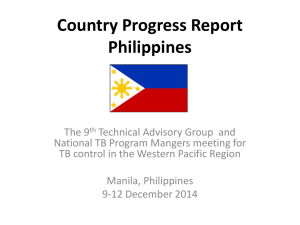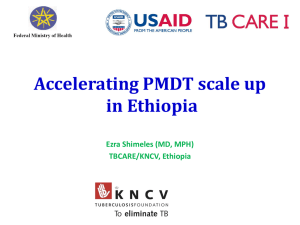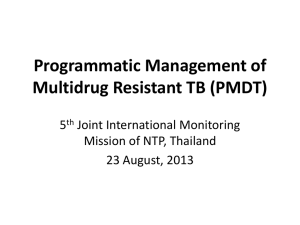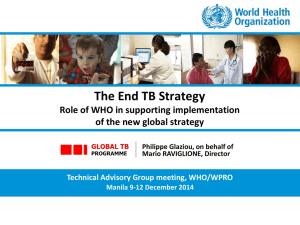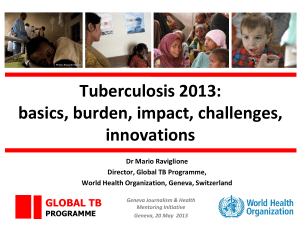Total - WHO Western Pacific Region
advertisement
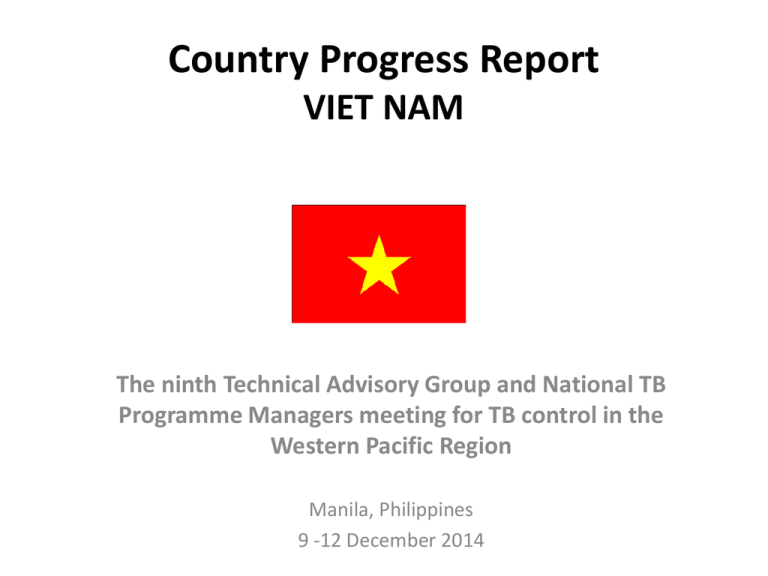
Country Progress Report VIET NAM The ninth Technical Advisory Group and National TB Programme Managers meeting for TB control in the Western Pacific Region Manila, Philippines 9 -12 December 2014 TB Epidemiology Estimated TB trends during 1990-2013 in Viet Nam Prevalence: Reduce 4.6% every year ¯ Incidence: Reduce 2.6% Lao PDR TB notification rate (per 100000) <50 50 - 99 100-149 150-199 >200 Cambodia Mortality: Reduce 4.4% every year Major successes 1. 2. 3. 4. 5. 6. The National Strategy for TB control (by 2020 with vision to 2030) has been approved by the Government, and disseminated to all localities and TB control facilities nationwide. Successful in the Joint Concept Note TB/HIV submitted to GF with the total budget was $ 42 M for 2015-2017 . Performance of activities under the GF during 2013 was rated at A1 and 6 first month 2014 was rated A2. Success in the targets of PMDT; TB/HIV; TB in children; PPM; PAL; TB in prisons; case-finding and treatment. Implementation of DOTS strategy: covered 100% of communes and population. Maintain high cure rate (~ 90% for new smear positive) and maintain high quality with LQAS (proportion of major error (0.14%) and minor error (0.83%). Health information system (VITIMES and e-TB Manager): maintain and expanded to district level, plan for fully upgrade and expansion nationwide in 2015. The TB control network is expanded and reinforced. With VSTP, strengthen collaboration with partners: Ministry of Public Security; MoLISA; VAAC; PATH; TB REACH; WHO; CDC, …central and provincial general hospitals. Major challenges 1. TB in Vietnam remains high (Both for the TB and MDR-TB) 2. PMDT: unable to detect all TB suspects, clinical case management and MDRTB patients management in community remain challenging. Treatment of TB patients outside the NTP with low successful rate, high default rate, which causes the increase of TB, especially M/XDR-TB. 3. Funding for ACSM works is limited due to state budget constraint and new mechanism of GFATM . 4. TB control work in closed settings remain challenging: lack of quality workers; lack of TB diagnostic and therapeutic equipments,.... while TB, MDR-TB, HIV infection rate in prisons is very high. 5. PPM activities remain limited. Almost collaborative activities are on referral of TB suspects. Recording activities are not yet done in private facilities. 6. Collaboration in detection of childhood TB between the NTP and pediatric facilities has not yet become routine and effective. Still lack of qualified health workers. NATIONAL STRATEGY ON TUBECULOSIS CONTROL TO 2020 WITH VISION TO 2030 - Objectives by 2015: + Reduce prevalence rate in community to less than 187/100,000 pop; + Reduce TB mortality rate to less than 18/100,000 pop; + Reduce MDR-TB rate to less than 5% among new TB cases. - Objectives by 2020: + Reduce prevalence rate in community to less than 131/100,000 pop; + Reduce TB mortality rate to less than 10/100,000 pop; + Maintain MDR-TB rate at less than 5% of total new TB cases. - Vision by 2030 Continue to reduce TB mortality rate and prevalence rate in community to less than 20/100,000 pop, moving forward to the aim of Vietnamese people living in a TB free environment. NATIONAL STRATEGY ON TUBECULOSIS CONTROL TO 2020 WITH VISION TO 2030 • The National Strategy on TB Control align with WHO End TB strategy • The National Strategy on TB Control align with National Health Sector Plan • Budgeted: Estimated ~ $ 663 M for 6 years 2015-2020 • Funding sources: • • • • • State budget as per annual budget law, Health Insurance fund, Funding from grants: Global Fund, CDC, USAIDS, WHO, TB Challenge, Woolcock Funding from local and international organizations and individuals Other legal funding sources Laboratory strengthening Existing lab test for TB diagnosis Focus on Smear: ZN, FM (Fluorescent Microscopy) Xpert: 46 LPA: Hain (FL, SL) Culture: Solid (Ogawa, LJ), liquid (BACTEC MGIT, MGIT) DST: Solid, liquid Laboratory quality assurance system • TA partners: from Adeline & WHO Reach the unreached • Intensive case finding: – Entry screening and periodic screening for early detection in prisoners – Implement active case finding in the provinces with low case-finding. • TB screening policy and practice: – Using CXR and Sputum smear examination for TB suspects (cough for more than two weeks) – Contact screening. – Active case finding for high risk groups • TB-HIV: – Collaborations between 2 programmes / Screening TB among HIV patients and testing for HIV among TB patients • Child-TB: – INH prevention – Screening for household contact – Intensified case finding with new algorithm for diagnosis of TB in children Surveillance • Quality of surveillance system: – Based on WHO-recommended paper-based system with quarterly reporting of cases – Transitioning to case-based electronic recording and reporting • Data entry at district level • Full national coverage planned for 2015 – Good internal and external consistency • New case definition: Planned to roll out in 2015 • e-R&R: VITIMES and e-TB Manager • Data is analysed and used at national and sub-national levels for reporting, planning, advocacy, evaluate the performance of the activities PMDT: Implementation process • Register with Green Light Committee (GLC): 12/5/2007; Approved by GLC: 29/6/2007; Pilot in HCM city: 101 patients (9/2009) • Expand in 6 provinces (2010) 20 provinces (2011, 12) 35 provinces (2013) 41 provinces (2014, 2015) • The accumulative number of enrolled patients until 9/2014 : 3509 MDR-TB patients Year Treatment centre 2009 2010 1 6 Satellite provinces Total 1 6 2011 2012-2013 2014-2015 6 10 10 14 25 31 20 35 41 Number of culture sample < 100 Culture Lab <500 3 Total >500 10 11 24 GeneXpert Lab 33 DST Lab 2 PMDT: Target & Implementation results Implementation 2009 2010 2011 2012 2013 2014 (9 months) The number of enrolled patients 101 97 578 713 948 1072 % of enrollment compared to total estimated number 3% 3% 16% 19% 25% 27% Total 3094 Target 2015 2016 2017 2018 2019 2020 Enrolment PMDT Provinces 2,200 2,500 2,900 3,000 2,900 2,800 41 50 57 63 63 63 Successful rate of MDR TB cohort in 2011: 73% PMDT in Vietnam: Difficulties • • • • • • • • Not yet 100% coverage of PMDT There is not yet new regimen for MDR-TB patients who have failed treatment, XDR-TB patients Second line drug procurement: long lead time TB drug in free market: not yet controlled Funding for PMDT is totally based on external funding (TB CARE & GF round 9): insufficient, sustainability ? Infection control: weak practice in community Palliative care: has not implemented yet Psychological – economic – social support is still limited PMDT in Vietnam: Solutions • • • • • • • • Strengthen basic DOTS for MDR TB prevention Increase PMDT coverage Plan for failed DR-TB, XDR-TB management: New TB drugs (BDQ introduction; Delanamid) Sustainable funding plan for PMDT, especially SLDs supply (local budget, health insurance) Control the distribution of TB drugs in free market and strengthen public-private mix DOT Improve infection control, especially in community Develop plan for palliative care for DR-TB patients Strengthen psychological-economic-social support for DR-TB patients during their treatment Bold policies and supportive systems 1. Involved the whole political system in TB control through the National Strategy 2. Establish TB Control Steering committee at all provinces 3. Develop a ACSM agenda to support policy changes, relevant law development 4. Advocate for new mechanism of health insurance to contribute in TB services 5. Update TB control guidelines and widely disseminate to all trained health care workers 6. Strengthen Viet Nam Stop TB partnership for engagement of all national and international stakeholders, including technical agencies, donors and corporate sector. 7. Strengthen capacity of the program at all level in term of Coordination, Supervision and Management Patient centred care: involvement of patients and civil society National strategy for TB control: TB control is mainly community-based and implemented by the whole TB and Lung diseases control network from central to local in collaboration with public and non-public health facilities and effective community participation 1.Encourage sub commune health workers to be involved in TB education, detection and follow up treatment 2.PMDT: Supporter 2 is trained commune worker (family member, social worker, …), transportation support, social, psychological consultation. 3.Farmer Union has TB Control Club: people can help to screen, refer and support each other financially and labour supports 4.Ongoing establishment of TB patient network to deal with stigma and experience sharing of successful story of TB treatment especially MDR TB treatment 5.Advocate for a TB treatment package cost of health insurance which included patient home visit and support.
